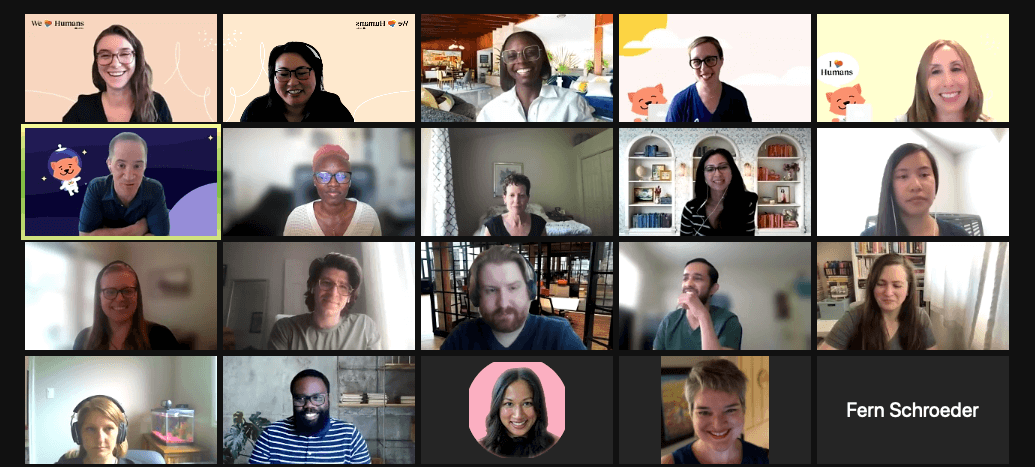On February 12, we brought over 16,000 HR professionals together for the first-ever Resources for Humans Virtual Conference. The event featured insights from over 20 inspiring leaders and visionaries. Speakers covered topics ranging from manager enablement to talent acquisition, offering actionable takeaways for every HR discipline.
Need a refresher on the content? We’ll highlight the conference’s most compelling themes. You can also rewatch the sessions on demand here.
1. Recruiting is still human — for now.
The past decade brought a lot of change to recruiting. One of the most exciting developments in HR technology is artificial intelligence. Technology’s growing role in recruiting came up during the conference’s morning session, Recruiting Trends for Hiring Your Next Top Performers.
“I think there's a lot that A.I. can provide to make recruiters work smarter and make talent teams more informed in their decisions,” said Mike Moriarty, Global Head of Talent at Dropbox. While he’s not advocating for robo-interviews any time soon, Moriarty thinks technology can free up valuable time for strategic work. “We always talk about teams wanting to have a seat at the table and I think A.I. can provide the clearance and capabilities for [them] to do so,” he said.
Mike Bailen, VP of People at Lever, echoed that sentiment. But to him, an equally important development is the rise of company-rating services like Glassdoor or Blind. “Candidates have a lot more information at their fingertips about organizations, which allows them to be more selective in who they actually want to speak to and engage with. I used to ask every single new hire what some of the channels or avenues were that they looked at, and 100% looked at Glassdoor,” Bailen said. Technology gives jobseekers a look behind the curtain.
Similar anecdotes were shared in Build an Employer Brand That Attracts Top Performers. “Companies need to be thinking about this because candidates won't even take a conversation with a company based on something they heard off the street or read on Glassdoor,” said Kelli Dragovich, Chief People Officer at Looker. While that might sound like bad news for recruiters, there’s a bigger upside: preventing costly mis-hires.
“The inside conversation that you're having is now happening outside...It's very authentic and clear, and it allows people to either opt in or opt out,” said Margo Downs, former Chief People and Culture Officer at Stitch Fix. Rather than try to please everyone, Glassdoor gives your company a chance to own its identity. “Not everyone wants to work for the same kind of company,” she said.
2. Management is all about trust.
Keynote speaker and bestselling author Kim Scott has had a lot of different managers over her career. When a family member fell ill, one of those managers told her to get on a plane and forget work.
Another manager, Sheryl Sandberg, told her she sounded “stupid” after a presentation for saying filler words like “um.” Scott ranked both managers among her favorites. The common thread? Both cared personally about their direct reports.
“Relationships don't scale, but culture does — and when a leader has those kinds of relationships with their direct reports, then their direct reports tend to have similar kinds of relationships,” Scott said. When you genuinely care about your employees, your feedback or “Radical Candor” isn’t mean-spirited or harsh. It’s just you looking out for your reports’ best interests.
“It’s not all about the boss criticizing the employee. Radical Candor is about soliciting feedback, it's about giving praise and criticism, and most importantly it's about gauging [and] understanding how it landed and helping other people do the same,” Scott said.
A similar case was made in How Continuous Feedback Can Level Up Performance. “At the end of the day, our employees are demanding feedback. They're demanding feedback because they want to grow and learn, and none of us can grow and learn without continuous feedback,” said Stephanie Garcia, SVP of People at Postmates. Managers are there to help develop employees, even if it means a few uncomfortable conversations along the way.
Building a feedback culture doesn’t happen overnight. But if you get managers into the habit early on, it can take root with their reports and the broader company. Amanda Myton, Director of Employee Development at Anaplan, has seen that dynamic play out firsthand. “If I can get momentum and help build those muscles, then that becomes part of the fabric of our culture,” she said.
3. Development doesn't always follow a set path.
Development isn’t about conventional feedback. It also isn’t about following a conventional path. Traditional career ladders keep professionals on a narrow, vertical trajectory within one discipline. Employees looking to pivot into new functions, like product managers interested in product marketing, haven’t had the easiest time getting buy-in from their bosses. The topic of unconventional career pathing was broached in The Career Ladder is Dead: Employee Growth Strategies to Help Retain Top Talent.
“Always remember that career development can happen in a lot of different ways,” said Nathalie McGrath, former VP of People at Coinbase. She believes that these conversations are more likely to happen at fast-growing companies. “I find that ‘hyper-growth’ is actually a great place for folks who want to go on a quick, steep route to learn a lot because there's so much to do,” she said.
Eventbrite actively encourages employees to share their career goals with managers, even if those aspirations lead them to other departments. Empowering top talent to move within the organization demonstrates your company’s commitment to development and gives managers plenty of runway to backfill roles. According to Elizabeth Pierce, Global Director of Learning at Eventbrite, managers who facilitate these moves should be celebrated.
“Make sure that you're harnessing what those really great managers are actually doing and you're celebrating them — you're showing [other managers] that, hey, this is a good thing for you to develop your employees,” she said. While managers are there to lead, they serve an equally important role as coaches and mentors.
John Meese, Creative Director at BambooHR, might have put it most succinctly. Management is about “being able to let go of responsibility...It is about engendering trust. ‘Yeah, I trust you. Go do that thing,’” he said. If you’re truly invested in direct reports’ growth, set them free.
4. Employees care about more than salary.
The cost of losing an employee can be double their annual salary. And in this job market, backfilling roles is anything but easy. Companies are pulling out all the stops to keep their employees engaged and feeling appreciated.
“The modern employee demands much more than those of the past. They crave personalization, they crave authenticity, and they crave choice. Recognition is no longer a one-size-fits-all option,” said Morgan Chaney, Senior Director of Marketing at Blueboard. Her session, In¢entive$ Rule Everything Around Me: The Psychology of Employee Recognition, covered the many ways companies are rewarding employees. Bonuses and monetary rewards are fleeting — public kudos and praise are lasting and on the record.
“Non-monetary rewards offer increased psychic value, they build the employee’s physical and mental trophy case, and they allow employees to treat themselves completely guilt-free,” she said.
The Future of Flexible Work introduced another powerful motivator. A recent study found that nearly a third of workers have sought new jobs because their employers didn't offer flexible work opportunities. For some, that means being able to work remotely when they need to. At InVision, a company with a 100% distributed workforce, it’s just how they do business.
“Our company was founded on the principle that we wanted to hire the talent where they were — not where we were,” said Linette Jensen, Director of People Operations at InVision. The company offers a full suite of perks to keep its remote workforce engaged, including wellness benefits, a meditation app, and a prepaid cafe card. InVision’s employees even have virtual happy hours, where employees shoot the breeze over drinks, all via webcam. “That makes it really fun and connected,” she said.
A growing number of companies leverage unlimited time off as a perk. But while attractive on paper, those policies sometimes result in employees actually taking fewer days off. Unclear expectations can also result in employees casually checking in while away. Heather Doshay, VP of People at Webflow, ran into that dilemma at prior roles. Webflow takes a unique approach to the issue: paying employees to go on vacation.
“Once employees go on that first vacation, we pay out a $1,000 first-vacation bonus if your first vacation is five days or longer,” Doshay said. Considering the high cost of employee burnout, disengagement, and turnover, identifying the perk’s ROI wasn’t a challenge. “It's so important to do that. It's really a low-cost investment,” she said.
5. Change is the only constant in HR.
HR veterans have seen a lot of change over the years. As technology automates or takes away certain responsibilities, company leaders have started to expect more from HR teams. According to keynote speaker and industry analyst Josh Bersin, that means a change of priorities.
“HR has an enormous responsibility in 2020...They need to develop and assess and support a new generation of leaders, work on the employee experience, and focus on the productivity and the performance management practices that people deal with and learn and live with every day,” said Bersin. Any of those priorities could make or break a company’s chances of success. That’s a lot of pressure for one department.
Bersin’s claim isn’t just academic conjecture — it’s an on-the-ground reality for Olivia Bair, Senior Director of Global HR at Instapage. Since she started in HR, not much hasn’t changed about her role. She shared some of those firsthand experiences in The Employee Engagement Metrics That Matter. “We’re not just about law and compliance anymore. We’re about engagement, we’re about development, performance, goal setting, and everything else that is part of that employee lifecycle,” Bair said.
Her co-panelist saw a similar transformation taking place. Gray Holubar, Associate Director of People Operations at Artsy, sees the profession evolving into a conduit between business and employee interests. While HR is ultimately there to help the company achieve its goals, to get there it needs to foster alignment between business targets and employees’ motivations.
“I think one of the most important concepts within engagement is this idea of intrinsic motivation, or ‘I am internally motivated and driven to work in this role,’” he said. Engagement comes when employees feel like they have a personal stake in business results. HR teams will need to help foster that sentiment in 2020 and beyond.
—
We hope you enjoyed and took away plenty of insights from this year’s virtual conference. Rewatch the sessions on demand here.
Want to keep the conversation going? Resources for Humans is a Slack community of over 6,000 people leaders who believe the best way to impact a business is through its humans. Together, we help each other navigate challenges by sharing resources and firsthand experiences. Click here to learn more about the free community.







.jpg)